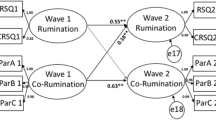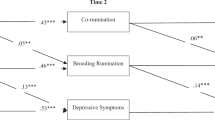Abstract
Purpose
This study examined whether rumination, the tendency to passively and repeatedly dwell on negative events, mediated the relationship between peer alienation and eating disorder symptoms among adolescent girls.
Methods
Participants included 101 girls (ages 10–14; 47 % Hispanic, 24 % African American) who completed questionnaires regarding peer relationships, symptoms of eating pathology, rumination, and depressive symptoms.
Results
Girls who reported experiencing more peer alienation reported a higher degree of pathological eating symptoms. The relationship between peer alienation and eating pathology was mediated by rumination, even after controlling for depressive symptoms.
Conclusions
This study extends previous work indicating that rumination is a cognitive mechanism that may contribute to the development and/or maintenance of eating pathology. The findings suggest that adolescents who feel alienated by their peers might be particularly susceptible to engaging in ruminative thinking that can lead to or exacerbate eating problems.

Similar content being viewed by others
References
Kuperminc GP, Blatt SJ, Leadbeater BJ (1997) Relatedness, self-definition, and early adolescent adjustment. Cognit Ther Res 21:301–320
LaGreca AM, Stone WL (1993) Social Anxiety Scale for Children-revised: factor structure and concurrent validity. J Clin Child Psychol 22:17–27
Rudolph KD, Conley CS (2005) The socioemotional costs and benefits of socio-evaluative concerns: do girls care too much? J Pers 73:115–137
French SA, Story M, Downes B et al (1995) Frequent dieting among adolescents: psychosocial and health behavior correlates. Am J Pub Health 85:695–710
Gerner B, Wilson PH (2005) The relationship between friendship factors and adolescent girls’ body image concern, body dissatisfaction, and restrained eating. Int J Eat Disord 37:313–320
Schutz HK, Paxton SJ (2007) Friendship quality, body dissatisfaction, dieting and disordered eating in adolescent girls. Br J Clin Psychol 46:67–83
Fairburn CG, Norman PA, Welch SL et al (1995) A prospective study of outcome in bulimia nervosa and the long-term effects of three psychological treatments. Arch Gen Psychiatry 52:304–312
Nolen-Hoeksema S, Wisco BE, Lyubomirsky S (2008) Rethinking rumination. Perspec Psychol Sci 3:400–424
Troop NA, Holbrey AL, Treasure JL (1998) Stress, coping, and crisis support in eating disorders. Int J Eat Disord 24:157–166
Troop NA, Treasure JL (1997) Psychosocial factors in the onset of eating disorders: responses to life-events and difficulties. Br J Med Psychol 70:373–385
Nolen-Hoeksema S, Stice E, Wade E et al (2007) Reciprocal relations between rumination and bulimic, substance abuse and depressive symptoms in female adolescents. J Abnorm Psychol 116:198–207
Rawal A, Park RJ, Williams MG (2010) Rumination, experiential avoidance, and dysfunctional thinking in eating disorders. Behav Res Ther 48:851–859
Hilt LM, McLaughlin KA, Nolen-Hoeksema S (2010) Examination of the response styles theory in a community sample of young adolescents. J Abnorm Child Psychol 38:545–556
Armsden GC, Greenberg MT (1987) The inventory of parent and peer attachment: individual differences and their relationship to psychological well-being in adolescence. J Youth Adolesc 16:427–454
Maloney M, McGuire J, Daniels S (1988) Reliability testing of a children’s version of the Eating Attitudes Test. J Am Acad Child Adolesc Psychiatry 5:541–543
Smolak L, Levine MP (1994) Psychometric properties of the Children’s Eating Attitudes Test. Int J Eat Disord 16:275–282
Shaffer D, Fisher P, Lucas CP et al (2000) NIMH Diagnostic Interview Schedule for Children Version IV (NIMH DISC-IV): description, differences from previous versions, and reliability of some common diagnoses. J Am Acad Child Adolesc Psychiatry 39:28–38
Abela JRZ, Brozina K, Haigh EP (2002) An examination of the response styles theory of depression in third- and seventh-grade children: a short-term longitudinal study. J Abnorm Child Psychol 30:515–527
Kovacs M. Rating scales to assess depression in school-aged children. Acta Paedopsychiatr 1980/1981; 46: 305–315
Saylor CF, Finch AJ, Spirito A et al (1984) The Children’s Depression Inventory: a systematic evaluation of psychometric properties. J Consult Clin Psychol 52:955–967
Preacher KJ, Hayes AF (2004) SPSS and SAS procedures for estimating indirect effects in simple mediation models. Behav Res Meth Instrum Comput 36:717–731
Streigle-Moore RH, Silberstein LR, Rodin J (1993) The social self in bulimia nervosa: public self-consciousness, social anxiety, and fraudulence. J Abnorm Psychol 102:297–303
Nolen-Hoeksema S, Davis CG (1999) “Thanks for sharing that”: ruminators and their social support networks. J Pers Soc Psychol 77:801–814
Abela JR, Vanderbilt E, Rochon A (2004) A test of the response styles and social support theories of depression in third and seventh grade children. J Soc Clin Psychol 23:653–674
Nolen-Hoeksema S, Watkins E (2011) A heuristic for developing transdiagnostic models of psychopathology: explaining multifinality and divergent trajectories. Persp Psychol Sci 6:589–609
Cowdrey FA, Park RJ (2012) The role of experiential avoidance, rumination and mindfulness in eating disorders. Eat Behav 13:100–105
Nolen-Hoeksema S, Jackson B (2001) Mediators of the gender difference in rumination. Psychol Women Q 25:37–47
Hilt LM, Pollak S (2012) Getting out of rumination: a comparison of three brief interventions in a sample of youth. J Abnorm Child Psychol 40:1157–1165
Acknowledgments
We would like to thank Christine Cha, Emily Lechner, Keneisha Sinclair, Gina Torcasso, and Andrew Jacobson for their help with this study. The authors thank the Robert Wood Johnson Foundation Health & Society Scholars program for its financial support.
Conflict of interest
On behalf of all authors, the corresponding author states that there is no conflict of interest.
Author information
Authors and Affiliations
Corresponding author
Additional information
Christina Roberto is a Robert Wood Johnson Foundation Health & Society Scholar.
We were saddened by the loss of Susan Nolen-Hoeksema who passed away before this paper went to press.
Rights and permissions
About this article
Cite this article
Hilt, L.M., Roberto, C.A. & Nolen-Hoeksema, S. Rumination mediates the relationship between peer alienation and eating pathology in young adolescent girls. Eat Weight Disord 18, 263–267 (2013). https://doi.org/10.1007/s40519-013-0042-y
Received:
Accepted:
Published:
Issue Date:
DOI: https://doi.org/10.1007/s40519-013-0042-y




